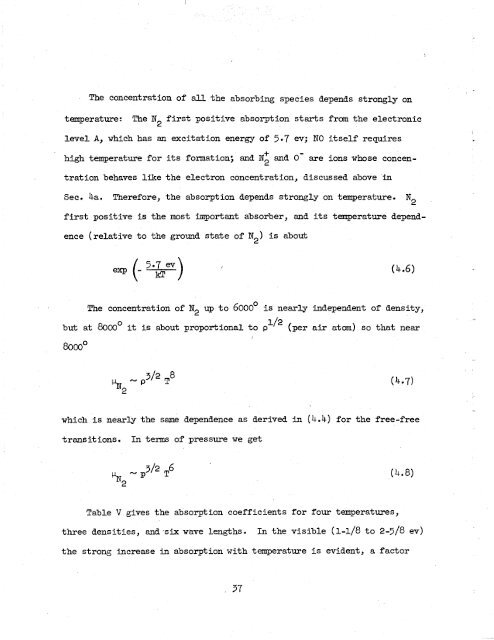Theory of the Fireball
Theory of the Fireball
Theory of the Fireball
Create successful ePaper yourself
Turn your PDF publications into a flip-book with our unique Google optimized e-Paper software.
The concentration <strong>of</strong> all <strong>the</strong> absorbing species depends strongly on<br />
temperature: The N first positive absorption starts from <strong>the</strong> electronic<br />
2<br />
level A, which has an excitation energy <strong>of</strong> 5.7 ev; NO itself requires<br />
high temperature for its formation; and N2 and 0- are ions whose concen-<br />
tration behaves like <strong>the</strong> electron concentration, discussed above in<br />
See. 4a. Therefore, <strong>the</strong> absorption depends strongly on temperature.<br />
first positive is <strong>the</strong> most important absorber, and its temperature depend-<br />
ence (relative to <strong>the</strong> ground state <strong>of</strong> N2) is about<br />
5.7 ev (- KT )<br />
The concentration <strong>of</strong> N~ up to 6000' is nearly independent <strong>of</strong> density,<br />
but at 80Wo it is about proportional to p1l2 (per air atom) so that near<br />
"N2 -<br />
3/2 ,8<br />
which is nearly <strong>the</strong> same dependence as derived in ( 4.4) for <strong>the</strong> free -f ree<br />
transitions. In terms <strong>of</strong> pressure we get<br />
Table V gives <strong>the</strong> absorption coefficients for four temperatures,<br />
three densities, and -six wave lengths. In <strong>the</strong> visible (1-1/8 to 2-5/8 ev)<br />
<strong>the</strong> strong increase in absorption with temperature is evident, a factor<br />
I 37<br />
+<br />
N2<br />
, .
















